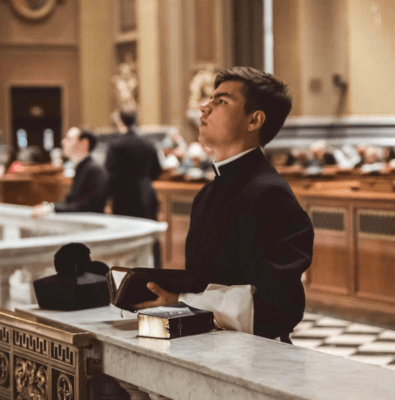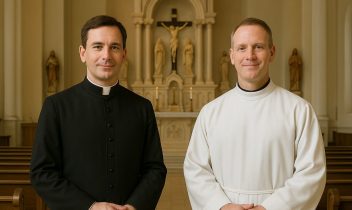No products in the cart.
Return To Shop
What Is the Meaning of Clergy Vestments?
Many individuals associate clergy vestments with a Black Clergy Robe featuring a white tab collar. This imagery is commonly depicted in movies and television shows portraying servants of God, shaping the perception of the masses. Moreover, when encountering priests outside of church settings, secular individuals often only witness them donning a Black Clergy Robe or a Tab Collar Shirt. Furthermore, mainstream culture tends to portray liturgical vestments as extravagant, sometimes symbolizing a departure from the righteous path by men of the cloth. However, as is often the case, reality proves to be even more intriguing and intricate than fiction.
Clerical Attire and Clergy Vestments didn’t initially serve to distinguish church members from laypeople. In fact, they largely resembled the modest clothing worn by common folk for centuries. Until the 4th century, Christian leaders dressed similarly to ordinary individuals, with the primary requirement being cleanliness during ceremonies. However, as secular fashion evolved over time, the church opted to preserve its traditions.
This isn’t to suggest that clergy vestments remained static. On the contrary, they underwent gradual changes with the availability of new materials and dyes. Nevertheless, the origins and significance of each garment piece can still be traced. It’s essential to distinguish between clericals and vestments.
Understanding Clergy Vestments
Clergy vestments encompass the special attire worn by those leading worship services. Despite their ceremonial significance, their origins trace back to humble beginnings, with many pieces being adopted from everyday wear in Greek and Roman cultures during the 4th century. While the quality and color usage have evolved over time, the fundamental style has remained consistent, contrasting with the ever-changing trends in secular fashion.
In practice, clergy vestments are meant to be worn over regular clergy attire, emphasizing that those in religious service are not elevated above others. Rather, the purpose of vestments is to conceal any fashionable or inappropriate clothing that may distract worshippers.
Although some outsiders perceive clergy vestments as ostentatious, their true effect is quite the opposite. They serve as equalizers, minimizing the distinction between leaders and clergy members, fostering uniformity, and reminding all that they are servants of a higher power.
Clergy Dress Code
Strict regulations govern the wearing of liturgical garments during worship and official duties. While clergy vestments hold deep spiritual significance, they primarily symbolize roles, functions, and order within the organization. Consequently, members are prohibited from using vestments to express personal opinions, political affiliations, or biases toward external causes. Impeccable attire from head to toe is expected of all clergy, as each individual represents the organization as a whole.
Bishopry in Christianty holds the highest rank, with bishops serving as mentors and overseers within their communities and beyond. Originating from the Greek word “episkopos,” meaning “overseer,” bishops are responsible for managing the administrative, temporal, and religious affairs of the church. In large denominations, regional or state bishops preside over dioceses, overseeing various ministries and ordaining new clergy members such as pastors and elders. These bishops often wear clerical attire even during official duties, adhering to strict dress codes in some denominations.
Modern denominations strive for a balance between solemnity and beauty, often adopting the motto of “Order with Ardour.” This approach allows for elaborate or adorned clerical garments, even featuring intricate patterns, during liturgical services while maintaining appropriate reverence.
What Are Clericals?
In essence, clericals serve as the attire worn by clergy members in their day-to-day activities. However, there’s nothing mundane about them; they are highly formal and must be kept immaculate at all times. Their primary purpose is to facilitate the recognition of church members within their communities, thereby increasing opportunities for discussions about Jesus. Typical clericals consist of tab collar shirts or a rabbat worn over a white long-sleeve neckband shirt.
While many commonly associate clericals with black hues, collar shirts can come in any color, fostering a more approachable demeanor for priests engaged in community work.
Although clericals are less formal than clergy vestments, they still command respect for the office and duties they represent. It’s not uncommon to see bishops wearing tab collar shirts, often adorned with distinctive purple hues, at informal worship services, dinners, ecumenical councils, and public church sessions.
Different denominations impose specific rules regarding the wearing of clericals. For instance, in the presence of the Presiding Bishop, other bishops may only wear purple clericals if the Chief Apostle is attired in red; otherwise, they must opt for black clericals. Wearing purple outside of one’s jurisdiction is generally disapproved of, varying according to denomination regulations.
Key Components of Clergy Vestments
The primary garment observed among clergy members is the robe, commonly known as the Roman cassock. Technically classified as a clerical or undergarment for vestments, the cassock is an ankle-length robe typically worn by religious individuals across various denominations. It features a button-down design from the neck to the ankles and is usually plain and unadorned. This simplicity serves two purposes: to maintain uniformity among clergymen and to emphasize their collective role within the organization, highlighting the importance of service over individuality.
In many Anglican denominations, bishops are permitted to wear colors other than black. For instance, during significant events such as Holy Communion, bishop installations, ecumenical worship services, graduations, and marriage solemnizations, the highest-ranking bishop dons a purple cassock. Purple also signifies participation in the dedication of secular facilities like hospitals and offering prayers at political functions such as inaugurations. Additionally, blue cassocks may be worn for somber occasions like Good Friday services, funerals, or chapel weddings.
[ux_bestseller_products products=”” columns=”4″ title=”Check our bestsellers!”]
If a bishop is spotted wearing a scarlet red cassock, it signifies their position as the Chief Apostle or Presiding Bishop, the highest rank in the denomination. While most bishops wear the purple cassock within their jurisdiction, they must switch to a black habit in the presence of higher-ranking officials or the General Board of Bishops.
A white rochet, reminiscent of traditional albs worn by medieval priests, is worn over the cassock. Serving as a symbol of purity and resurrection, Anglican rochets are ankle-length tunics with long sleeves, adorned with wrist-ruffs and bands matching the cassock’s colors.
Next in the ensemble is the chimere or surplice, a sleeveless robe worn over the rochet and cassock. Evolving from the medieval tabard, today’s chimere is ankle-length and open at the front. When used for liturgical purposes, chimeres must match the colors of the cassock and rochet’s bands.
The zucchetto, a small skullcap worn during church services, has its origins in the Middle Ages when headwear was forbidden. Designed to keep aging clerics warm, zucchettos must match the cassock’s color during official duties.
Lastly, bishops adorn a matching cincture around their waist, typically made of silk and identical in color and material to the cassock or robe.
Diverse Styles of Clergy Vestments
Different ranks and occasions dictate the use of various vestments among clergy members. Jurisdictional bishops, for instance, are limited to wearing black cassocks and chimeres, but they must display a purple cincture during ceremonies attended by higher-ranking officials to denote their jurisdiction. Conversely, auxiliary bishops do not wear purple as they lack jurisdiction.
As previously mentioned, cassocks technically function as undergarments. During services and official missions, clergy members are required to wear vestments to emphasize the sacred nature of the occasion. Vestments also serve to enhance the beauty of worship and provide insight into a clergy person’s position within the organization.
Apart from cassocks, other elements such as the tippet or stole also indicate the rank and office of ordained priests. The tippet, a long rectangular cloth draped vertically from each shoulder, symbolizes the yoke of office and must match the cassock’s color. Originally used for warmth in medieval times, tippets are now made of silk or lightweight fabrics and can be worn by any clergy member.
In contrast, stoles are worn similarly to tippets but carry the seal of office or denomination symbol, serving as signs of order and authority. These are exclusively worn by ordained priests during official duties. The Christian tradition encompasses various elements that have often been misunderstood but possess deep historical significance and meaning.
For expert advice on clergy vestments or to explore a potential path into the priesthood, feel free to contact us or visit our showroom in Dale Blvd Woodbridge, Virginia. Clergy Wear Shop not only offers clericals and vestments online but also welcomes in-store visits for firsthand experience with liturgical garments and accessories.
Contact us at +1(929)330-6666 to schedule a visit and ensure you make informed decisions before making a purchase.
[ux_sale_products columns=”4″ title=”Check our Products on Sale!”]
Frequently Asked Questions (FAQs)
What are clergy vestments?
Clergy vestments are special garments worn by clergy members during religious ceremonies and official duties. These garments hold symbolic significance and vary depending on the denomination and specific role of the clergy member.
What is the purpose of clergy vestments?
Clergy vestments serve multiple purposes, including symbolizing spiritual roles and functions within the church hierarchy, maintaining uniformity among clergy members, and enhancing the reverence and solemnity of worship services.
What are some common types of clergy vestments?
Common types of clergy vestments include robes, cassocks, surplices, chimeres, rochets, stoles, and tippets. Each garment may have specific meanings or purposes depending on the denomination and the occasion.
Why are clergy vestments often plain and unadorned?
Clergy vestments are often plain and unadorned to emphasize humility and to prevent distractions during worship services. The focus is on the spiritual significance of the garments rather than their aesthetic appeal. What Is the Meaning of Clergy Vestments?
Are clergy vestments mandatory for all clergy members?
The use of clergy vestments varies among denominations and individual churches. While some denominations require clergy members to wear specific vestments during worship services, others may allow more flexibility in attire. What Is the Meaning of Clergy Vestments?











Add comment
You must be logged in to post a comment.